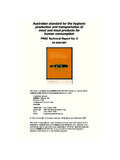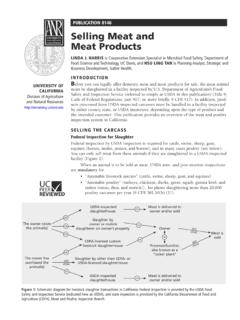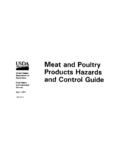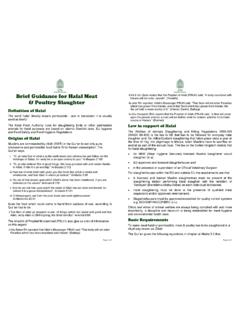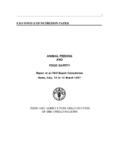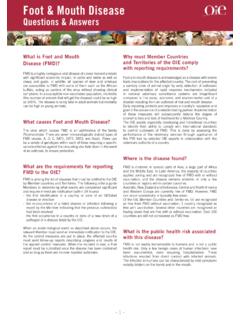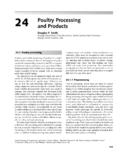Transcription of SOUTH AFRICAN POLICE SERVICE STOCK THEFT …
1 1 SOUTH AFRICAN POLICE SERVICE STOCK THEFT UNIT INFORMATION BROCHURE 1. STOCK THEFT ACT, 1959 (ACT NR 57 OF 1959) SECTION 6 Document of identification to be furnished by person who disposes of STOCK : Section 6 (1) Any person (including any auctioneer, agent or market who sells, barters, gives or in any other manner disposes of any STOCK to any other person shall at the time of delivery to such other person of the STOCK so sold, bartered, given or disposed of, furnish such other person with a document called a document of identification. Section 6 (3) Any person to whom a document of identification has been furnished in terms of subsection (1) shall retain it in his possession for a period of at least one year.)
2 SECTION 8 STOCK or produce driven, conveyed or transported on or along public roads: Section 8 (1) provides that no person may drive, convey or transport any STOCK or produce which he/she does not own on or along any public road unless he/she has in his/her possession a certificate (removal certificate) issued to him/her by the owner of the STOCK or produce or the duly authorised agent of the owner. 2. ANIMAL IDENTIFICATION ACT, 2002 (ACT NR 6 OF 2002) SECTION 7 Duties of owners: All owners of cattle, sheep, goats & pigs must register an identification mark at the office of the registrar of animal identification.
3 Each owner must mark his/her animals in the prescribed manner. All cattle, sheep, goats & pigs of which the identification mark have become indistinct or invisible, must be re-identified in accordance with the legal provisions. Any owners of an animal with an identification mark on it, who wants to sell, barter or give away the animal within 14 days after he/she became the owner of such animal, must provide the new owner with a document of identification. This means that within 14 days the animal can be disposed of without having being branded with the new owner s mark since it already has the previous owners mark on it & a document of identification has been issued.
4 An owner of an animal who wants to sell, barter or give away an animal, must mark the animal with his/her own mark before disposing of it. The owner must also provide to the new owner a document of identification. The new owner must keep the document of identification for a period of one year. This means that after 14 days the animal cannot be disposed of without having being branded with the new owner s mark & a document of identification. 3. AGE OF ANIMALS AT THE TIME OF MARKING (REG 11) Cattle Can be tattooed from the age of one month.
5 Must be marked by the age of six months Can be branded at the age of six months - & Must be branded by the age of the pair of permanent incisors (two-tooth stage). 2 Small STOCK Must be tattooed at the age of one month. Pigs Must be tattooed at the age of one month. Ostriches Can be tattooed at the age of one month - & Can be branded at the age of six months. Equine Can be tattooed at the age of six months - & Can be branded by the age of twelve months. 4. MEAT SAFETY ACT 2000 (ACT NR 40 OF 2000) SECTION 7 Prohibition of slaughter of animals at places other than abattoirs, and exemptions: Section 7 (1) provide that no person may- a) Slaughter any animal at any place other than an abattoir; b) Permit the slaughter of any animal at any place under his or her control, unless the place is an abattoir; or c) Sell or provide meat for human and animal consumption unless it has been slaughtered at an abattoir.
6 Subsection (1) does not apply to slaughter for own consumption or for cultural or religious purposes. Section 7 (2) provide that no meat or animal product obtained from an animal slaughtered as contemplated in paragraph (a) may be sold to any person. 5. HINTS Livestock-owners should keep all fences & gates in proper condition to protect their livestock. The employment of a specially trained employee can be considered for daily fence patrolling. He can see to it that holes in & under fences are repaired at once. Inspect these reparations yourself. Loading ramps in paddocks or on farms away from direct supervision should be kept locked or obstructed at all times.
7 If you consider buying an additional farm, remember, absentee landlords gather no crops . Rather try & buy close to your residential farm. Prevent stolen animals from being hidden on your property. STOCK -posts serve as ideal overnight stopovers to hide livestock. Unknown livestock found at such posts should immediately be reported to the SAPS. Livestock at STOCK posts should be counted by the livestock-owner him-/herself, at least once a week. If employees at STOCK posts possess their own animals, a good preventative measure against STOCK THEFT , (if involvement of employees is suspected) is to allow the animals to mix & graze together.
8 Many court cases are lost because of disputes regarding the proper identification of animals. If an animal is marked with a registered brand or tattoo, disputes will be avoided. Employees should properly mark their livestock, according to the Animal Identification Act, 2002 (Act No 6 of 2002), preferably by branding them. 3 Be particularly watchful during the full moon, weekends & at the end or beginning of a month, or during periods that you know from your own experience, when STOCK thefts (slaughtering for the pot) occur. Report unknown animals among your animals immediately to the SAPS & your neighbours.
9 Livestock-owners should at all times report all livestock THEFT cases on their property immediately. The longer you delay, the less the possibility of achieving success. The regular herding & counting of animals are of obvious importance. Also check up upon your employees livestock. If it is not possible to count your livestock everyday, try counting your animals at least twice a week on irregular days. Avoid any routines, especially at STOCK posts, as your employees may be informers to STOCK thieves. Shortages & signs indicating possible thefts should immediately be reported.
10 The livestock-owners must count the animals him-/herself & can not leave it to his/her employees to do the counting or to lodge any complaints. When considering applicants for employment, enquiries should be made at previous employers to establish the real reason why an employee had left his previous work. Enquiries should also be lodged at the SAPS to determine whether the applicant has a criminal record. Establish what kind of criminal record the applicant has. Employees should be trained to pay attention to irregularities. Ask your employees to watch what they say about activities on the farm in the presence of strangers.



